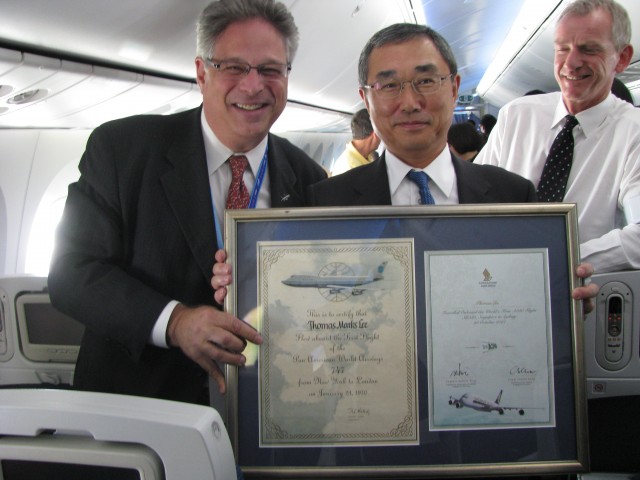
Thomas Lee with Mr. Shinichiro Ito, the CEO of All Nippon Airways, while flying the inaugural 787 flight. Photo from Thomas Lee.
AirlineReporter.com (AR): Who is Thomas Lee?
Thomas Lee (TL): I am a 60 year old businessman, originally from New York, who earned my Engineering degree from Tulane University and now reside in Orange County, California. I am married to Sally Glenn-Lee, who was President of the first class of flight attendants at Southwest Airlines and has worked her entire career in the airline industry, currently with jetBlue. I am father to Briana Lee, a 28 year old nurse and grandfather of Tatiana, an adorable 3 year old. I am Director of Marketing and Innovation in the Galleys and Equipment Segment of Zodiac Aerospace, a $4B entity with 26,000 employees globally. Every day, I work on developing the aircraft passenger cabin of the future and proudly have dozens of patents.
AR: What inaugural flights have you been on?
TL: I flew on the inaugural flight of the B747 in January 1970, a Pan Am flight from New York to London; the inaugural flight of the A380 in October 2007, a Singapore Airlines flight from Singapore to Sydney, Australia; the inaugural flight of the B787 in October 2011, an All Nippon Airways flight from Tokyo to Hong Kong and the inaugural US domestic B787 flight in November 2012, a United Airlines flight from Houston to Chicago.
AR: What is the allure of going on the inaugural flight of an aircraft?
TL: It is terribly exciting to be amongst the very first passengers to board a brand new aircraft type and experience the magic of flight in the latest aircraft technologies. One can decide for oneself whether new innovations have improved air travel. The atmosphere on these flights is electrifying. Aviation enthusiasts from around the world, airline management and the media all converge to join in the festive nature of each new aircraft launch. It is simply exhilarating.
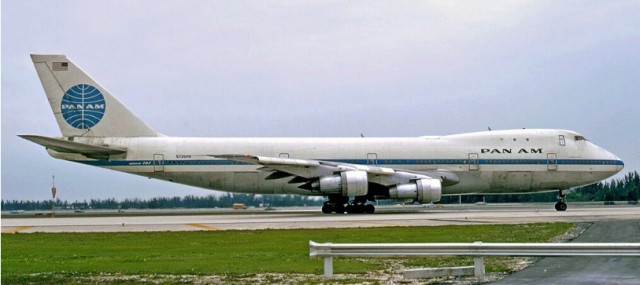
Thomas’ first inaugural flight was on this PanAm Boeing 747-100 named Victor Clipper (N736PA). Photo by Bob Garrard taken in 1973.
AR: What has been your favorite inaugural flight?
TL: My favorite would have to be the very first inaugural flight, that B747 in 1970. This was the first twin-aisle aircraft, so it was simply overwhelming boarding this behemoth when all past flight experiences had been on narrow body, single aisle planes. And it was no ordinary flight. After boarding the aircraft, every seat was filled and we taxied out for take-off. At nearly full take off speeds, there was a flame-out in engine #3 and the captain had to jam on the brakes aborting the take-off. The plane was rolled back to the gate.
Pan Am had fortunately received a second 747 just the day before from Boeing. It was parked in the hangar and was a completely green airplane with no preparation work done to get it ready for passenger service. To waste as much time as possible, Pan Am arranged for 5 extremely large Greyhound buses to pick us up at Kennedy Airport and take us to an Italian restaurant that they had completely taken over. We had a full sit-down dinner there and a long party waiting for that second aircraft to be prepped for flight.
By the time we got back to Kennedy Airport and boarded the second plane, so much time had elapsed that the first aircraft would have already landed in London. At least 30 passengers refused to board the aircraft, fearing something horrible would happen.
Another memorable part of that flight was that they didn’t have time in the rush to prepare the plane to transfer all the catering carts and equipment. So, the flight attendants laid out a buffet in the galley and we all lined up in the passenger aisles to make our way through the galley and pick up plates of food. What an amazing night.
By the way, that second plane was ’œClipper Victor’ which seven years later was involved in the worst aircraft accident in history. A KLM 747 at full take off speed, while trying to get airborne crashed into Pan Am’s Clipper Victor in Tenerife.
AR: All together, about how many miles have you flown?
TL: I would estimate that I have flown about 7.3 million miles in my life.
AR: When normally flying, what is your favorite aircraft type?
TL: I have been partial to the Boeing 777 aircraft from its inception. This was the first large commercial plane ever developed entirely on computers. The interior space feels great; the way it flies is extremely comfortable, etc. There has never been a fatal accident on a B777 which attests to its amazing design and engineering.
AR: What is your favorite airline?
TL: There are many great airlines in the world. Each creates its own brand based on that airlines ’œpersonality,’ which is driven by their culture, style of service, menus, etc. It would be impossible to pick one and say it is the best.
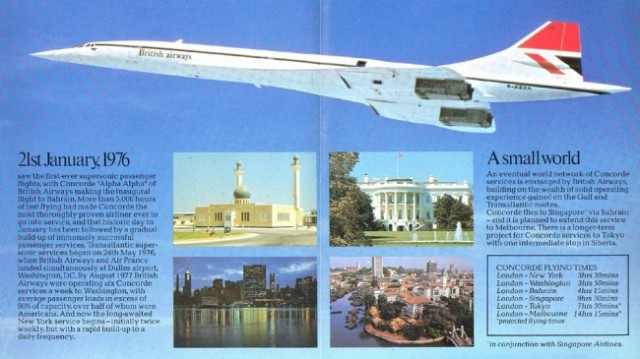
1977 – British Airways Concorde U.S. Launch Brochure. From Chris Sloan / Airchive.com.
AR: What is the inaugural flight you missed and wish you made?
TL: The Concorde as this was the first supersonic passenger aircraft. I was privileged to fly the Concorde three times and found it fantastic to look out the window at 60,000 feet and see the blackness of space above and the curvature of the earth below.
AR: Why did you not go on the Lufthansa 747-8 inaugural?
TL: I typically like to focus on ’œfirst of aircraft type’ inaugural flights. As the Lufthansa 747-8 was a ’œderivative’ aircraft, I chose not to join this journey. Of course, that doesn’t make any inaugural less exciting, but I have elected to limit my experiences to those aircraft types making their maiden voyages.
AR: What is the next inaugural flight you are planning to make?
TL: I suspect the most likely next inaugural to attempt will be the Qatar A350.
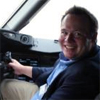 |
This story written by…
David Parker Brown, Editor & Founder. David started AirlineReporter.com in the summer of 2008, but has had a passion for aviation since he was a kid. Born and raised in the Seattle area (where he is currently based) has surely had an influence and he couldn’t imagine living anywhere else in the world.
@AirlineReporter | Flickr | YouTube |
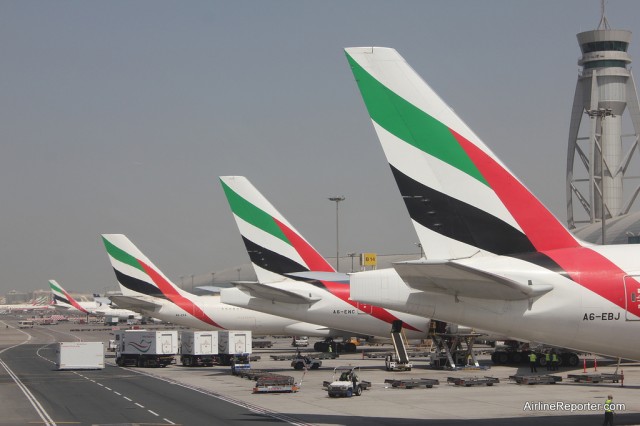
Line of Emirate’s tails in Dubai.
Recently, I had the ability to ask Patrick Brannelly, Emirates Airline Vice President – Corporate Communications, Product, Publishing, Digital & Events, some questions about Wi-Fi and the future of entertainment on the airline. Here is our discussion:
AirlineReporter.com (AR) How many Emirates aircraft currently have Wi-Fi available?
Patrick Brannelly (PB): The whole A380 fleet (currently 21 aircraft) has Wi-Fi. We’ll be getting another 10 A380s before the end of 2012 and they’ll all have Wi-Fi as well. We’ll also be introducing the ability to use your own mobile phone next month on our A380s ’“ a service that we already have on over 90 of our other aircraft (we launched that service in 2008).
AR: What is the schedule for the entire fleet to be fitted?
PB: Going forward, all A380s will have the service and we aim to start fitting the rest of the fleet with internet before the year end. It will take some time to equip the entire fleet but we are working on accomplishing this as quickly as possible.
AR: Are new Airbus/Boeing aircraft equipped with the Wi-Fi?
PB: Yes for our A380s and we hope to have our Boeing 777s equipped from mid-2013.
Why did Emirates choose OnAir?
OnAir was the only option offered by Airbus for equipping the A380 fleet straight out of the factory ’“ they have provided a good service and we are happy with them.
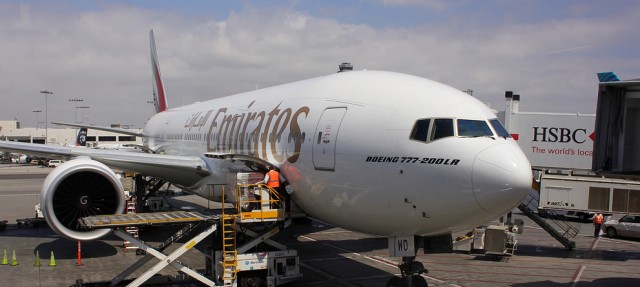
Emirates plans to install Wi-Fi to their 777 fleet in the future.
AR: Currently, Wi-Fi pricing is set up based on the amount of data used and how do passengers patrol/control the amount of data used?
PB: Customers buy a package of data, either 5MB or 30MB for mobile or 30MB/100MB for laptops. They can see their current usage and decide whether to buy extra MB or cut off at the limit.
AR: Is Emirates looking at offering an unlimited plan?
PB: The above packages are often more than most people need during their flights. Over two thirds of passengers use less than 20MB and only 1.6% of passengers use more than 100MB.
AR: A recent APEX story shows the record being at 680MB, has that been broken yet?
PB: It’s still a record ’“ 680.51MB was used on our New York flight on Valentine’s Day. Someone in love perhaps!
AR: What is the current pricing structure?
PB: We may tweak this pricing in time, but currently users can connect a mobile from as little as $2.75 for 5MB of data. This is more data than most will need to connect socially throughout even a long flight. We also have a heavy (30MB) mobile package available for $15 but few opt for it. Laptops can connect from as little as $5, and there is a heavy user package for $15 for 100MB. These prices are low for satellite connectivity, but we see this as a service to our customers rather than a profit centre (in fact we lose money).
AR: What are the usage statistics? Is there growth?
PB: Yes ’“ we are still seeing growth. This is probably because awareness is still growing about the service and because increasing numbers of people are carrying on devices that can connect. We see over 4% of passengers connect on the very long flights of over 12 hours (such as New York / Sydney etc.) but much less on flights under 5 hours (less than 1.5%).
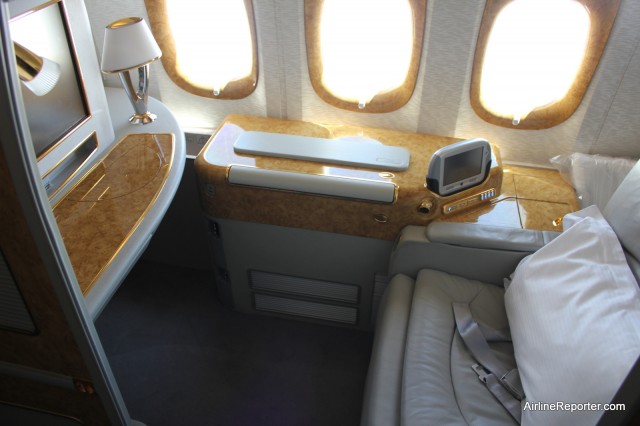
Emirates already offers a pretty slick product. Adding Wi-Fi will only make it better. This is First Class seen on a Boeing 777.
AR: Are there any plans to offer on-board Wi-Fi entertainment options (where passengers can access Emirates entertainment from their personal devices via Wi-Fi)?
PB: We are looking at all options ’“ but with over 1,300 channels of the latest and greatest entertainment available on your large screen personal TV for every Emirates customer, the need to play media on your own device is reduced.
AR: Will passengers be able to access the internet through ice (the name for the entertainment system)?
PB: We hope so but not at the moment. There are some technical issues, largely to do with the seatback’s light-browser’s capability to connect to the internet for a good experience. You really need a mouse and a keyboard at the moment and that’s not practical. However, we are working on it.
AR: Are there dark spots where passengers will not be able to have internet?
PB: The OnAir service uses Inmarsat’s geo-stationary I4 satellites which cover the entire globe except for the extreme poles (above about 80 degrees). There are also a few countries that are yet to provide approval to use the service in their airspace, so we have to block it… but these are reducing.
AR: What digital “wonders” from Emirates can passengers expect for the future?
PB: Emirates has led technology in the air for 20 years or more. From being the first airline to install TVs on every seat on the entire fleet in 1992 to today, when we’ve introduced services such as mobile phones and internet inflight, as well as large HD capacitive touch screens onboard our latest 777s. Rest assured we have a lot more innovation coming, but we tend to talk about it when it’s ready to launch rather than before’¦
RELATED EMIRATES AIRLINE STORIES:
* Inside the Emirates Flight Catering facility in Dubai
* Emirates First Class Lounge Review in Dubai
* My Review: Flying Emirates Airline Business Class to Dubai
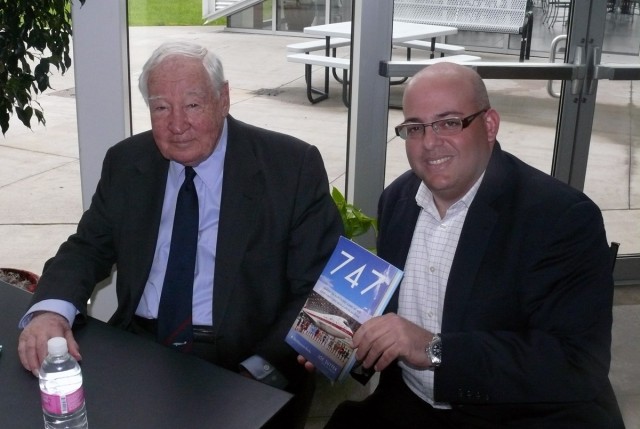
Chris Sloan (on the right) gets his Boeing 747 book signed by Joe Sutter (father of the 747) during the recent Lufthansa 747-8I Delivery.
I first met Chris Sloan during ANA’s delivery celebration of their first 787 Dreamliner. However, I already knew his name. I had previously seen his work in Airways Magazine and I knew of his site Airchive.com, although I didn’t realize he was the man behind it. We have quickly bonded over airlines and enjoy sharing our unique stories with each other.
When it comes to airline collections, there is no question that Chris has me beat. He has so many airline collectables it blows the mind. Luckily he has spent a great deal of effort to share his collection with the rest of the world. I wanted to learn a bit more about him and his website. Here is our interview:
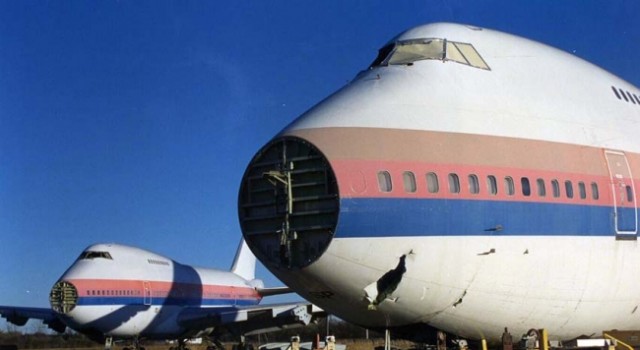
An old United Airlines Boeing 747-100 and 747SP at Ardmore Graveyard. Photo by Chris Sloan / Airchive.com.
AirlineReporter.com (AR): What is Airchive.com?
Chris Sloan (CS): Airchive.com is what I call an online ’œwebseum of commercial aviation’. I strive to be different from other sites out there that do pure plane-spotting, breaking news, and travel reviews so well. We are basically an online museum of commercial aviation with some contemporary twists:
We curate timetable, route maps, airline and manufacturer memorabilia of 1000s of airlines going back to the 1920s to the present. We really try to write a historic perspective of the history of an airline or aircraft model through it’s memorabilia and route maps.
Another thing that sets us apart is our focus on airports. Lots of attention, and rightly so, is directed to plane spotting which Airchive.com does but we feature virtual in-depth photographic tours and background info on airports around the world. We are as interested in the terminals as we are what’s on the ramp. Likewise, these virtual tours extend to aviation museums with slide-shows that transport the user there virtually. One of our most popular sections are rare photographic behind the scenes tours of airplane manufacturers such as Boeing and Airbus
Other unique features include detailed galleries on airliner cabins, scrapped airliners, airline models (including cutaways), and aviation firsts such as trip accounts of the inaugurals of the Airbus A380, Boeing 787 Dreamliner, and the upcoming Lufthansa Boeing 747-8 Intercontinental Inaugural.
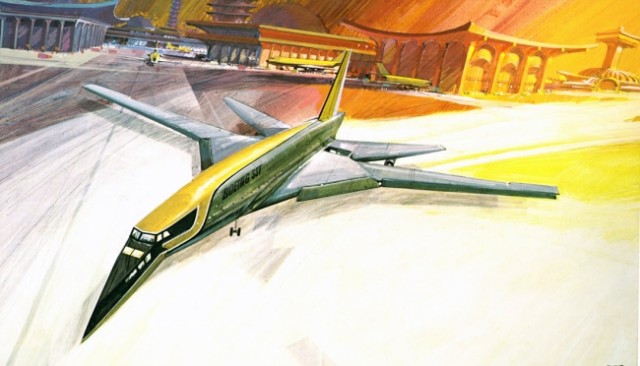
An image from the Boeing SST 2707 brochure from 1966. Chris Sloan / Airchive.com
AR: Why did you start it?
CS: I started the site back in 2003 as a way to give back to the commercial aviation community and share my massive collection as others had done online in person. It has turned into a passion project which has allowed me to meet many other folks of similar passion and undertake unique experiences. Also, at this time, the airline industry was engaged in the nadir of it’s turmoil following 9/11 and running up to the Gulf War II, so I wanted to remind the flying public and airline staff just what an incredible industry they have. I now try to tweet @airchive relevant items everyday to provide a historical or different take on what is in the airline zeitgeist.
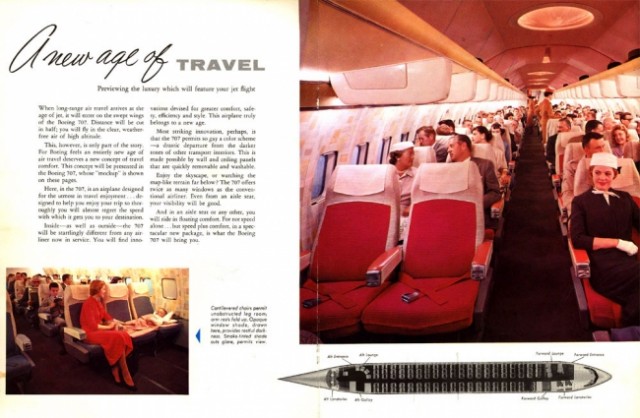
1955 Boeing 707 Intro Brochure. Image from Chris Sloan / Airchive.com.
AR: When did you get into collecting airline memorabilia?
CS: I began collecting at the age of 6 years old. I would visit airports and city ticket office’s back then when those existed, and pester airline reservation agents to mail me timetables, route maps, safety cards, whatever. I’d also inhabit my favorite airports snapping off photos. It’s a life-long passion but I frustrated that I didn’t have anyone to share it with. At this point, my model collection numbers over 300 including gigantic 747, DC-10, and Concorde cutaways; 10,000 timetables, brochures, airline seats, service items, even a desk made from the wing of the Lockheed L1011 prototype. I am not in this for the money. In fact, to borrow an old stock market adage ’œI buy and hold.’ I have never sold anything, though have donated and loaned items to other museums.
As I have grown older running my own TV production company which leads to extensive travel ’“ this only increases my enthusiasm for this fascinating industry. One cool thing is I have combined some business with pleasure such as overseeing the John Travolta hosted documentary on the building of the Airbus A380, back when I ran production at TLC, and now creating and executive producing a reality series called ’œAirport 24/7: Miami’ which is an unprecedented behind the scenes look at all the goings on at Miami International Airport. It’s a compelling, eye opening show for enthusiasts and non-enthusiasts alike. It will premiere later in the Summer on Travel Channel.
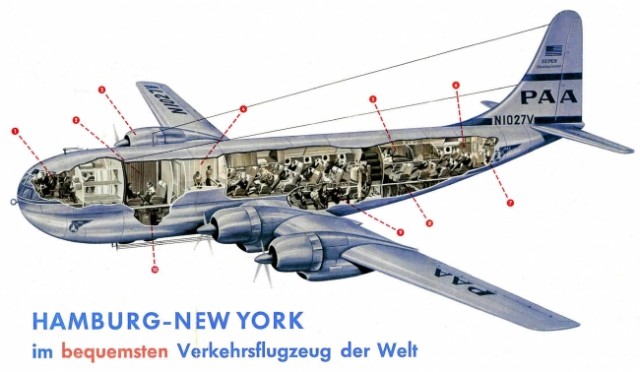
Cutaway of a Pan Am Boeing 377 Stratocruiser. Image from Chris Sloan / Airchive.com.
AR: Have you ever thought of starting some in-person museum?
CS: This is a long-term goal, or if I win the lottery a short-term goal, to either start my own or collaborate with others of like-minded interest. My ’œdreamseum’ would be a cross between LAX’s Flightpath Museum and the Delta Airlines Heritage Center and American’s C.R. Smith Museum. It would cover a broad swath of airlines like Flightpath but with the depth and actual aircraft of C.R. Smith and Delta Heritage. As a passionate Miamian, I would like it to have a South Florida focus on Pan Am, National, and Eastern.
I have taken part in public displays where I loaned materials out. There was a Museum of Modern Art (MOMA) Exhibit at the former TWA Terminal T5 @ JFK a few years back, but unfortunately about $5000 of my collection was stolen and never recovered so I am much more careful these days. Who would’ve thought MOMA didn’t carry insurance.
AR: What is your favorite piece you have on the site?
CS: Hard to say, so I will list some of my favorites:
* Boeing brochure for the 2707 SST
* The original US Air Force presentation for Air Force One
* Anything and everything involving my favorite airlines: Delta, Pan Am, Continental, Braniff, and National
* Complete timetable collections for major U.S. airlines going back to their histories
* My young son has come now has the bug. In fact, he is named after artist Alexander Calder who designed the Flying Colors Boeing 727 for Braniff. I have an autographed poster from Calder.
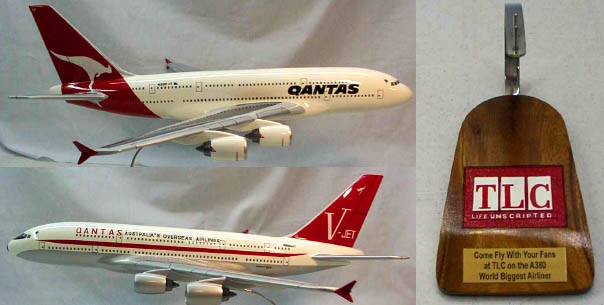
A special Qantas Airbus A380 model given to Jon Travolta. Photo by Chris Sloan / Airchive.com.
AR: What has been your favorite airline related experiences?
CS: Shooting with John Travolta the A380 doc was incredible. Such a gracious man and an enthusiast extraordinaire. As a reward, we all went up in an Airbus A-320 chartered for the shoot, and he took the controls. It has also been exciting being a part of three inaugurals and deliveries including the Airbus A380, Boeing 787 Dreamliner and the Lufthansa Boeing 747-8 Intercontinental.
Meeting the Father of the Boeing 747, Mr. Joe Sutter at the Lufthansa Boeing 747-8 Intercontinental Delivery. Spunky, Pugnacious, and Outspoken’¦
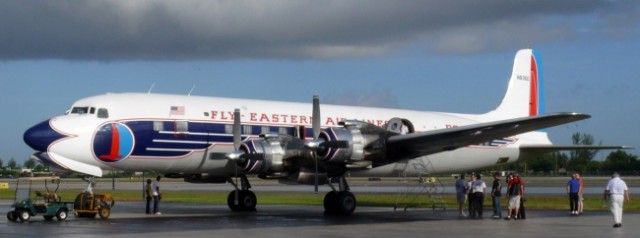
Eastern Air Lines Douglas DC-7B at Opa Locka - August, 2010. Chris Sloan / Airchive.com.
Chartering the world’s only flying passenger DC-7 for a company party high over Miami. We buzzed the beach at 1,000 feet. Travolta and his daughter came on one of our flights from Miami to Key West where Pan Am was founded. Countless private ramp tours of LAX, Miami, and Mojave. These are hard to get and very gratifying, especially when friends and family have joined in awe as an A380 lands 100 feet away.
Flying the jump-seat from LAX to Hong Kong on a Boeing 747-400 back in 1999. Visiting the not open to the public Boeing Archives. The Airline Reporter has been there too, so you know how awesome it is.
Photographing the Boeing and Airbus Factories and Customer Delivery Centers and flying a CRJ-200 sim through moderate to serve turbulence, with the radar painting read, and trying not to throw up!
Being on the inaugural of the Virgin America service to Florida with my idol, Richard Branson.
Producing our Travel Channel Series about the Miami International Airport. We actually created an airborne parade of a DC-7 and DC-3 which proceeded the Lufthansa A380 landing in Miami for the first time. And of course, all the international travel such as flying into Hong Kong Kai-Tak during its last days.
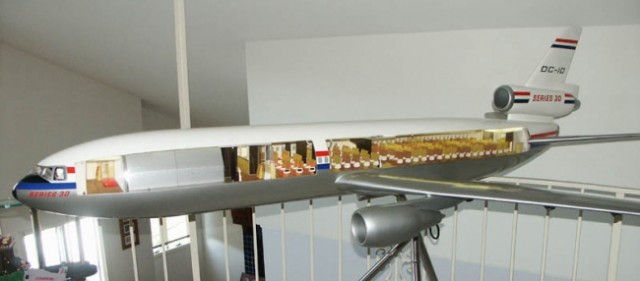
A very rare 1973 vintage factory DC-10 cutaway. Image from Chris Sloan / Airchive.com.
AR: How many airline models do you have?
CS: 100’s literally but the pride and joy are 3 restored cutaways: 1 of 3 Douglas DC-10 Prototypes made for the factory back in the 1960s to demo the airplane. Also a Concorde cutaway that used to apparently be in the lobby at the Bristol Fulton Factory. It was in found in the attic of the interior designer of the Concorde, after 20 years.
I also have a 7 foot long 1974 circa TWA Boeing 747 restored over 3 years to its original condition and an original Boeing 747 prototype cutaway circa 1969
AR: What is Airchive.com’s relationship with Airways?
CS: I have been an avid reader of ’œAirways’ since it began publishing. In fact, I deserted commercial aviation for many years until 1994 when I picked up one of their first issues in an airport newsstand. I was immediately infected again by the bug. I still eagerly await my issue each month like every other enthusiastic subscriber. We have a strong cross-promotion and content-sharing relationship. As well, I am a frequent contributor to this excellent publication as it really speaks to my passion.
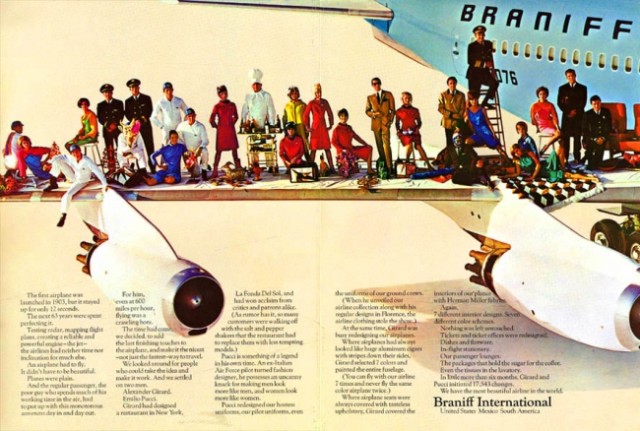
1965 "End of the Plain Plane" ad campaign for Braniff. Image from Chris Sloan / Airchive.com.
AR: What do you want to add?
CS: I view Airchive.com as pure passion. It takes a lot of time and money, frankly but it is a passion. It has been so much fun, particularly getting my sons interested in this field and meeting so many interesting, like-minded people. I get a lot of gratitude when people write from around the world how much the site inspires them or takes them back to memories they had in the business. When someone says ’œI got lost for hours on Airchive’, that is the greatest compliment. I am adding features to allow more contributors as many wonderful folks send me items and photographs. As my children get older and business obligations grow, it gets harder to do this on your own. So I welcome anyone who wants to get involved and collaborate. We’re all stronger together then apart.
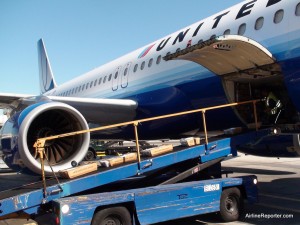
Working on the ramp can be pretty exciting. No, Matt does not work for United, but this is a photo I took while in LAX on the ramp.
Working as a ramp agent for an airline can be exciting and challenging. I was recently able to talk to a ramp agent, Matt, and learn a little bit more about what it is he does. I am purposefully not sharing the airline or airport that Matt works at (you might be able to narrow it down with some of the answers), so that he could be honest without worrying about saying the wrong thing. Here is our interview:
AirlineReporter: When did you start working for your current airline?
Matt: I joined the airline in December of 2006 as temporary Christmas help and was hired on permanent the following month. The company lists my date of service as being in January, but lists my seniority date in December. The way they went about moving me from temporary to permanent involved firing me one day and rehiring me the very next. It was a strange experience (for me at least, this may be commonplace in the industry, I’m unsure) having it handled in such a way and has caused some headaches through the years (most recently involving my vacation allotment for the coming year).
AR: What is the biggest challenge you find with your job?
M: I’d say the biggest challenge in my job is dealing with the apathy amongst my colleagues. Those that have been with the airline over the past decade have had to endure a bankruptcy and the subsequent cuts to their salaries & benefits. There is very much a divide between management and the front line staff (though there is an air of change with a relatively new CEO in charge, so I’m seeing an improvement) and the years of friction have worn on everyone. Dealing with that on a daily basis is definitely a challenge, but I try to keep in mind that I’m here for the passengers and am an important link in their having a good experience while flying with us.
AR: What is your favorite part of the job?
M: There are actually two aspects of my job that I enjoy: The first is helping out passengers. While I am a ramp attendant, and I don’t have much interaction with our passengers on a daily basis, I do enjoy the moments where I get to help them out.
The second aspect is one of the functions I can be tasked with as a ramp attendant. Running connecting bags from inbound flights is a challenging job that requires sound decision making and time management skills (especially in cases where you’re running domestic, trans-border & international connections from one flight). It’s a function where you’re either on the ball or getting run over by it and can be hectic at times, but it’s the most enjoyable function that I’ve found in my time with the company.
AR: What is the worst part of your job?
M: The least favourite part of my job is another function. Working the lavatory truck is just the worst thing one can do there. Surprisingly, some employees aspire to the position, but for me it’s the function I dread.
AR: What is the worst day in your job that you can remember?
M: It shouldn’t be a surprise then that my worst day involves working the lav truck. The G8/G20 summit was on that day (a great week for spotting on the field) and we had a thunderstorm pass through the area, closing the ramp for over an hour. Lav blocks (the schedule of flights for the shift) are typically tight, so having a delay made things that much worse and I ended up working back-to-back-to-back flights with no chance for a break until late in the evening. I had a 777 on the block, so I had to make time to empty the truck before servicing that flight, else I might not have had enough room in the tank. I went to the lav dump bay and emptied the truck and headed back to the 777. At some point along the route, the lever that controls the valve on the tank opened. I didn’t catch it and ended up emptying a tank and a half of lav waste on to the ramp (you can probably get the stats from Boeing as to the capacity for each tank on a 773ER – I’d love to know). I then spent the next three hours spreading Absorball on to the mess & shoveling it into cans for disposal. It was the absolute longest and most physically draining day I’ve ever had.
AR: What is your favorite aircraft to work?
M: My favourite plane to work is still the 77W (777-300ER). It’s perfect. The lines are smooth and graceful and the aircraft just looks right. The 77L (777-200LR) doesn’t hold the same appeal, despite being from the same family. The proportions, to me, just don’t look right – the aircraft fuselage looks too short to my eye in comparison with it’s engines (though, the 772 with the PW engines looks a little better proportionally than the GE90 77L).
AR: What is the weirdest thing you have found on an airplane?
M: This is another story from last summer (seems to be the summer for things happening). I was on a ramp crew for the summer bid and we were working an outbound flight. The bags were brought out and we were told by the runner that they had some bags that were rather smelly and would be coming out last.
Nothing out of the ordinary there, we’ve dealt with oddly scented baggage before, so we thought nothing of it and went about the onload. Sure enough, as promised, the smelly bags made their appearance and we loaded them on the plane. I was out of the hold by this point and was loading bags on the belt. I didn’t envy my coworker who was in the hold, loading the bags. It wasn’t long before the hold was filled with the scent of the mystery meat and he was having trouble coping with the scent. Thankfully, he was at the door at this point, so he was getting some fresh air. Eventually though, he was overwhelmed by the smell and had to get out of the hold as he started gagging.
We were talking at the top of the belt when this happened and he told me he was going to throw up because of the smell. Of course, he said this while facing me and I told him to throw up on the catering truck and not on me! I didn’t think the smell was that bad. You could smell it outside of the hold, but it wasn’t as strong as it was mixing in with the breeze. I’ve never been so wrong about something in my life.
We had a few more of the bags to load, so I grabbed the next one and proceeded to load it. It had been wrapped in a plastic bag, but the bag had had a hole ripped in it (presumably by someone testing the smell factor). When I set the bag down, the air that was in it proceeded to rush out the hole and I got a small whiff of rancid monkey meat.
We were told that it was monkey meat that was in the bag. I can’t be completely sure that it was actually monkey, it was at least plausible. The smell churned my stomach and I started gagging myself. I’ve worked lavs and I figured that was pretty bad smelling on its own, but this bag was of a whole other magnitude. Who knew meat that had been sitting in a bag for two days, unrefrigerated, could smell so very bad?
I had a fun conversation with the pilots when I went to do the pre-departure communication check. Apparently, the smell had made its way into the cabin and they could smell it on the flight deck and were wondering what it was. I told them what it was and they had a good chuckle about it. We eventually ended up offloading the bags and the passenger (who claimed she had no meat in her bags) and they were left for the midnight baggage agents to deal with.
AR: Do you ever wave to passengers on the airplane?
M: I’ll wave to passengers on board if they wave first – I feel a bit awkward doing it otherwise. It’s usually the kids on board that will wave and they get the biggest kick out of it when you wave back. The smile is priceless.
AR: Do you think you will ever leave the airline business?
M: I can’t ever see a time when I won’t be in the industry in some capacity. I’m an airline brat who was building crude model aircraft in kindergarten out of scrap wood (back in the day when they let you play with a hammer an nails at that age); the smell of burnt kerosene gives me goosebumps; watching an airliner liftoff into the sky makes me believe in magic. There is just something about being there, around the planes, that makes me content. This is the industry where I belong. I have been debating taking a temporary leave however, as I want to further my education and the current options I have where my work schedule are concerned make it difficult to achieve that goal. I’ll have to see what the summer bid brings and make a decision from there.
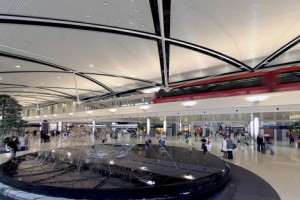
The tram wizzes by at Detroit's airport. Photo from DTW.
Recently I was hanging out at Austin-Bergstrom International Airport (AUS) waiting for a flight back home and I became annoyed that their airport did not provide free Wi-Fi internet. Oddly the airport did have free wired terminals were folks could check their email. I have become a spoiled traveler. Seattle-Tacoma International Airport (my home base) has had free internet for quite some time. The more I travel the more and more I start finding free wireless access at airports. Heck, while waiting for the bus in Austin to go to the airport, I got free Wi-Fi from the city of Austin while standing at my bus stop.
I was voicing my frustration about no free Wi-Fi at AUS via Twitter, when Scott Wintner, who works for Pubic Affairs for Detroit Metropolitan Airport (DTW) and Willow Run Airport (YIP), reached out via Twitter and wanted to share why many airports do not offer free Wi-Fi. He pointed out that Wi-Fi isn’t free and not all airports can afford to give it to passengers without charging. I decided to try and learn more about why more airports don’t have free Wi-Fi and Wintner was more than happy to help out. Here is our talk:
AirlineReporter.com (AR): When did DTW get Wi-Fi?
Scott Wintner (SW): December 2003
AR: Who is it through?
SW: Concourse Communications (now part of Boingo)
AR: How much does it cost a passenger to get internet?
SW: The rates are established by the provider (Boingo), which currently offers several different rates and packages. You can find all of their rate/package info online at www.boingo.com (there are many to choose among). It’s important to note that, because we use one of the leading global providers, internet purchased for use at DTW also works at hotspots around the country and, with some plans, the world. Plus, customers who already have a Wi-Fi plan with another carrier with which Boingo currently has roaming agreements (such as AT&T, T-Mobile, etc.), you can login to our Wi-Fi using your existing account.
AR: How much does DTW get from each internet purchase?
SW: That’s a complicated question because it’s not as simple as a flat % or sum per transaction. So, the best I can offer you will likely be an annual total’¦ which our finance folks are working on for me now. Please standby’¦
AR: How much did it cost DTW to set up Wi-Fi?
SW: It didn’t cost the Airport Authority anything because the system was developed by the provider (Boingo). They may be able to provide you with more info about how much a system such as the one in place at DTW costs to set-up and maintain.
AR: Does “free” Wi-Fi even exist?
SW: There is ’œno such thing as free Wi-Fi’. A wireless internet infrastructure costs money to develop and maintain’¦ no news there. So, that cost has to be paid by someone. When you stay at a hotel that offers free Wi-Fi, you can bet that the cost of providing the service is merely baked-in to their operating costs and reflected in room rates. Likewise, when you go to a coffee shop, etc., that offers ’œfree Wi-Fi’, the cost of providing that service is assumed in the price you pay for a latte or a bagel there. Of course, a for-profit business could elect to absorb the cost of providing Wi-Fi by paying for it out of profits rather than charging more for their goods/services. I don’t think it’s likely for many businesses to choose that option. But, either way, someone is paying for the cost of providing internet ’“ and generally, it’s the customer.
AR: How do airports differ?
SW: Unlike hotels (which charge for a bed) and coffee shops (which charge for caffeine), airports do not charge their customers to use the airport. Yes, airports do charge for ancillary services such as parking and food/beverage/retail, but those services aren’t the airports primary reason for existing. Airport customers can ’“ and many do ’“ pass through the facility without spending a dime. So, airports can’t just jack-up their nightly rate or their admission fee to cover the costs of providing free Wi-Fi ’“ there are no such fees to raise. Sure, airports could jack-up the price of parking and concessions to cover the cost of Wi-Fi ’“ and many probably do.
AR: Can’t the costs be added to the airline’s fee for flying to an airport?
Raising airline costs at airports creates a whole separate set of effects. At minimum, those added airline costs become reflected in ticket prices. But, in most cases, added airline costs become a huge disincentive for airlines to expand (and in some cases even maintain) air service at that airport’¦ which could lead to fewer options and less competition (read: higher prices). In either case, travelers are ultimately paying the bill.
AR: Why has DTW decided not to provide “free” Wi-Fi?
SW: While finding a way to cover the cost of providing Wi-Fi is one thing, here in Detroit (as at many airports), we take it a step further. Much like parking, food and retail, we approach Wi-Fi as an important revenue stream. It’s not a matter of lining our pocketswe don’t make a profit and haven’t run a surplus in our 100 year history. Meanwhile, we have an incredible airfield here and two beautiful, new terminals that need to be both paid-off and maintained. We get a lot of kudos on our facilities here, and both travelers and airlines appreciate that we rarely have delays to due capacity issues at DTW. But, maintaining J.D. Power & Associates #1 Airport in customer satisfaction takes money. We have to get it from somewhere’¦ and, for the reasons I described above’¦ it’s incumbent upon us ’“ for the good of the community ’“ to generate as much revenue from non-airline rent sources as possible.
AR: How much does Wi-Fi factor into the airport making money?
SW: Wi-Fi is a tiny percentage of our overall revenue, but it’s something ’“ and, it at minimum pays for itself. We hope it can pay us even more, because our customers enjoy the things such revenue is used to pay for (i.e., heat, hot water, clean bathrooms, working escalators, a tram that whisks connecting customers through the mile-long Concourse A in 2 min to make their connection, clear runways, top-notch safety and security systems, etc.)
AR: Why do any airports provide “free” Wi-Fi then?
SW: To that question, I refer you back to my first key point ’“ it’s not really free. How do some airports justify increasing costs elsewhere to cover providing free Wi-Fi? That you’d have to ask other airports. But, for smaller airports, it’s often for competitive reasons. Lots of people say to me, ’œI can’t believe you don’t have free Wi-Fi’¦ even the tiny LANSING airport has free Wi-Fi,’ ’“ as if to suggest that a smaller airport would be the last to offer such a service. In reality, those smaller airports need to find ways to incentivize travelers to use them (and I say ’œsmall’ loosely ’“ airports such as OAK are actually not that small, but they are the ’œlittle guy’ competing aggressively for Bay Area traffic). In their case, airlines aren’t likely to serve their airport unless the airport can show that travelers demand such air service. The economics of the smaller ’œspoke’ airports are just entirely different than hub airports.
AR: Is there anything else travelers should know about DTW?
SW: Despite being a major hub for Delta (their second-largest), and formerly the largest for Northwest, DTW has an impressive roster of other carriers. Since we became an independent Airport Authority in 2002 (which largely affected our economics in terms of a focus on lowering airline costs), we’ve added service by Frontier, AirTran & Air France’¦ and have gained new service on Southwest, Spirit & US Airways. All of those carriers fly routes also and already flown by NW/DL, which means we’ve been able to keep the economics to these carriers good enough to take-on an established hub carrier in their own hub and not only be successful, but GROW. That’s not easy to do ’“ look at CLE today, MSP (until very recently), EWR, etc. We’ve done it with our focus on low-cost operations. We’re not the Nordstrom of airports’¦ we’re more like the Target of airports. People fly out of DTW because they know they’ll get great rates and good service with LOTS of options all under one roof.
Hmm, okay I guess I have to be forgiving of this. How can I say it is alright for airlines to charge fees on things, since I shouldn’t have to pay for what I do not use, when I demand “free” Wi-Fi at the airport. It might be a bit selfish of me to ask others to help pick up with bill for Wi-Fi when not everyone will be using it. Just it can be difficult to pay out $10 for airport Wi-Fi, then another $10 for Wi-Fi on the plane. Of course, no one is forcing me to pay for it.

















